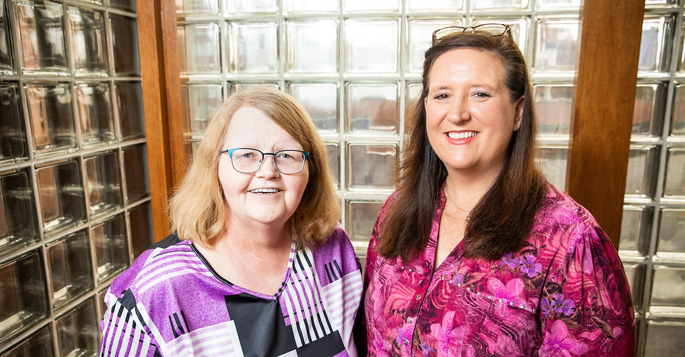
Each passing day is precious for Deneen Eastridge of Killen, Alabama, but a decade is a priceless gift.
A survivor of acute myeloid leukemia, Eastridge recently hugged Trina Hughes, the stem cell donor who gave her the gift of life 10 years ago. Hughes traveled from Dallas to Nashville in June to meet Eastridge.
“This is my sister,” Eastridge said as they walked together at Vanderbilt-Ingram Cancer Center, noting that they share the same blood. Her face beamed with happiness and gratitude. She thanked Hughes, she thanked God, and she thanked Adetola Kassim, MD, professor of Medicine and clinical director of the Adult Stem Cell Transplant Program, who was her doctor.
Eastridge endured multiple rounds of chemotherapy, including one last blast of intensive therapy to get her into full remission. Then in 2012, she learned that a match had been found, giving her hope for a potential cure. She underwent a conditioning regimen, which entailed even more chemotherapy, to achieve adequate immunosuppression so that her body wouldn’t reject the stem cells.
“I spent the whole month of March 2013 in Nashville, getting my platelets down to zero,” she said. “I spent a lot of time at the hospital.
Eastridge was linked with Hughes through Be The Match, which is operated by the National Marrow Donor Program. Hughes had signed up to be a donor 13 years earlier while training to run a marathon for the Leukemia & Lymphoma Society which was sponsoring and raising funds for an 8-year-old girl in need of a transplant. The girl received her transplant from someone else who matched, but Hughes’ information remained on the registry.
“All those years later, I got a phone call at work informing me I was a match,” said Hughes, who was working as a high school educator at the time but is now retired. “I was amazed that all these years later, something like that could pop up. It was a voicemail at my work. I called them back, and they told me about the process and what all would happen.”
She received the phone call in October 2012, underwent more bloodwork to confirm that she was a match and completed a physical. But in February 2013, she received a letter that the transplant would be postponed because her recipient wasn’t ready. However, three days later she received a telephone call and was told to disregard the letter.
In March 2013, she spent her spring break preparing for the donation, receiving injections of a drug called filgrastim to increase the quantity of blood stem cells in her bloodstream. At the end of the week, she did a peripheral transplant, a process where her blood was removed through a needle in one arm and passed through a machine that collected the blood-forming cells. Then her remaining blood was returned to her through a needle in her other arm. Other than feeling tired the next day, Hughes had no complications.
“I really appreciated the communication from the registry,” she said. “It was nice after a few weeks to hear that my recipient had received the marrow and was doing well and was still in the hospital. Later, I received another call that she had gotten out of the hospital.”
One year after she made the stem cell donation, Hughes received a letter notifying her that she could reach out to Eastridge. The two women began emailing one another and then became Facebook friends. The friendship evolved into phone calls and finally the chance to meet in person.
Eastridge has reason to be grateful because not everyone in need of a stem cell transplant is matched with a donor. Siblings have only a 1 in 4 chance of matching a recipient, and 70% of people don’t have a fully matched donor in their family, according to Be The Match’s frequently asked questions. Depending upon a patient’s ethnic background, the chance of finding a match is between 29% and 79%.
White people have the best odds of finding a match, while people from ethnic minority groups or with mixed heritages have lesser odds. Seventy-five percent of the unrelated stem cell transplants performed in the United States in 2021 were for white non-Hispanic recipients, according to the Center for International Blood & Marrow Transplant Research.
It’s crucial that more people join the Be The Match registry to be donors, especially people from ethnic groups that are underrepresented on the registry, said Eastridge’s doctor.
Seventy-five percent of the unrelated stem cell transplants performed in the United States in 2021 were for white non-Hispanic recipients.
“We need more representation in the National Marrow Donor Program for ethnic minorities to improve donor availability,” Kassim said.
The evening before their visit to Vanderbilt, Eastridge and Hughes met for the first time in person at a hotel suite with a kitchen. They brought their mothers along. It was like a family reunion. Eastridge made spaghetti following her secret recipe and then shared it with Hughes.
“I came to Nashville to meet my donor, but I left with a sister and an extended family to add to mine,” Eastridge said.












